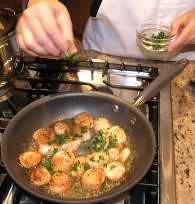Itanglish: Italian Food in English
 There are many things I love about living in Italy. The food is one. Here you are in good hands of the mamas behind the furnace. They might have a few emancipated papas also... ha!
There are many things I love about living in Italy. The food is one. Here you are in good hands of the mamas behind the furnace. They might have a few emancipated papas also... ha!Restaurants plenty. And the average quality is way up there. Even from the down-to-earth “family restaurants around the corner”. Plus living right at the sea, gives plenty of sea food offerings too. I was raised at the Belgian coast, as you might know, so I never say “no” to fresh fish.
 The Italian way of cooking is straightforward. Nothing fancy. Concentrated on the food, not the presentation (unlike French food). However, the Italian servings are a bit complicated… They strictly separate certain dishes, we (the other members of the world) would normally see as part of a main course, into different courses. Antipasti (the appetizer), Primo (typically the pasta), Secondo (the meat or fish main course).. Easy once you get used to it.
The Italian way of cooking is straightforward. Nothing fancy. Concentrated on the food, not the presentation (unlike French food). However, the Italian servings are a bit complicated… They strictly separate certain dishes, we (the other members of the world) would normally see as part of a main course, into different courses. Antipasti (the appetizer), Primo (typically the pasta), Secondo (the meat or fish main course).. Easy once you get used to it.The main challenge for foreigners, however, remains the language barrier. Not many visitors to this country speak Italian. So often I see people choose blindly. Hoping they will not be served bull testicles on vinegar or seasoned intestines. In addition the average Italian speaks little or no other languages. No lack of trying. Even though the effort sometimes leads to more confusion, in this land which thrives on (trying to be politically correct here!) utter confusion and comic anarchy.
 That also goes for the food and the restaurants. They try. But the more they try, the more confusion it often creates (sounds like their politics).
That also goes for the food and the restaurants. They try. But the more they try, the more confusion it often creates (sounds like their politics).The other night, one of the owners from a restaurant we regularly go to, proudly presented an English and German version of his menu.. I think he might have use the Internet for the translation... Some excerpts:
“The voices marked by asterisk could be frozen if the sea doesn’t allow the coolness.”
And: “The chef is to illustrate and to propose the consequential alternatives from the fished fresh.”.
Or: “The fish from the navies tirreniche of Anzio and Brings Saint Stephen, and from the navy of Mazaro of the Go him/it.” Eh.. Sounds pretty good, no?
But that was just the introduction. Then come the dishes (again, all from real life examples):
- “Croccantini of it gleans” (Croccantini di spigola) Would it be radioactive?
- “Hypocrites of sea” (Tartufi di mare) – Must be Shakespearean
- “Carpaccio of it gleans raw” (Carpaccio di spigola crudo) – More radioactivity.
- Of course “Paccheri con gallinella e pachino” translates into “Paccheri with gallinella and pachino”. Clearly!
- “Taglioni with porky mushrooms” (Tagliolini fungi porcini) – only for pork lovers.
- “Half sleeves to the granchione” (Mezze maniche al granchione) – I hope it was a clean shirt!
- “Scorfano in the crazy water” (Scorfano all’acqua pazza) – Must be with vodka
- The Germans get a hard time too: “Funghi porcini” translates in German to “Porcini schiebt wie Pilze aua dem Bodem” (something like “Porcini dug like mushrooms out of the earth”). And “Pinzimonio” is clearly “Rohe Gemuese mit kurzem Bad auf der Seite” (in English, this is as much as "Raw vegetables with a short bath on the side").
- Luckily Ovoline is just “Ovoline”. - That is clear.
- Sometimes the portions must be huge. Like the “Fig trees of Indian” (Fichi d’India)
- And others are unintentionally poetic “Twisted to the Kiss with peanuts” (Torta al bacio) or “Twisted to the fruits of wood” (Torta ai frutti di bosco)
- Sometimes it does not sound too kosher: “Fried dor-mouse” according to the German translation, these must be mice: “Gebratene Hasel Mause” (Moscardini fritti).
Well, what can I say? At least they try. And that is more than other nationalities would do! I am sure this menu must attract tourists too. Who want to have a laugh while they eat!
Picture Italian dish, courtesy of AnnaMaria Volpi
Continue reading The Road to the Horizon's Ebook, jump to the Reader's Digest of The Road.
 Peter. Flemish, European, aid worker, expeditioner, sailor, traveller, husband, father, friend, nutcase. Not necessarily in that order.
Peter. Flemish, European, aid worker, expeditioner, sailor, traveller, husband, father, friend, nutcase. Not necessarily in that order.
0 comments:
Post a Comment